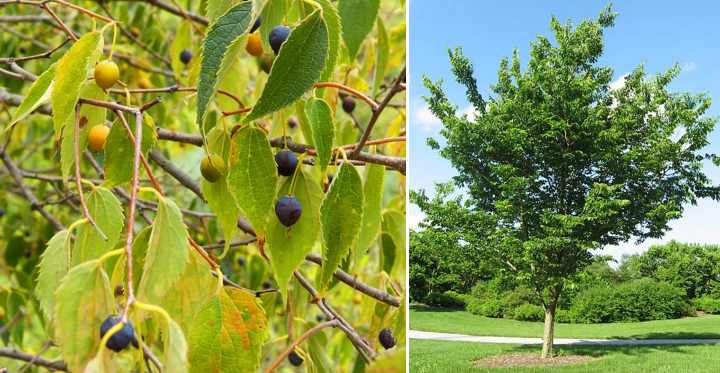Hackberry (Celtis) is a genus of medium-sized, deciduous trees with long ovately-shaped leaves, clusters of tiny fuzzy spring flowers, and little purple fruits. Drought, wet soil, strong winds, and air pollution are just a few of the conditions that low-maintenance hackberry trees can tolerate. Hackberries are well-suited as shade trees or lawn trees in garden landscapes because of the tree’s thick, spreading leaves and rounded crown.
The most frequent kinds of hackberry trees are described in this article. Recognize these tough landscape trees by learning about hackberry leaves, bark, blossoms, and fruit.
Hackberry Tree (Celtis) Facts
The hackberry tree, which grows 40 to 60 feet (12 to 18 meters) tall and broad, is a deciduous tree. While immature, the lovely landscape tree has a pyramidal crown. As the tree grows, it produces an open, spreading canopy of arching zigzag branches that droop at the ends. The hardy, robust trees of the nutling belong to the family Berberidaceae. As a result, native hackberry trees may be found growing in most soil types, from poor to fertile ground.
The genus Celtis contains around 60 different hackberry tree species. Many states in the Midwestern and Eastern regions of North America are home to the common hackberry (Celtis occidentalis). In addition, Texas and other warm states in the south are home to several hackberry species, including the sugarberry (Celtis laevigata). USDA zones 2 to 9 are optimal for hackberry trees. Zones 5 to 10 are ideal for sugarberry, also known as southern hackberry. The majority, though, of the genus Celtis trees can withstand frost.
Sugarberry, sugar hackberry, nettle tree, American hackberry, and beaverwood tree are all popular names for species of hackberries. Sugarberry is the name given to both Celtis occidentalis and Celtis laevigata, which refers to the sweet drupes that ripen in the fall.
In the deciduous tree order Rosales, hackberry trees are related to elm trees. You may see that the leaves of hackberry trees and American elms are similar when you compare them. Hackberries and elm trees may be distinguished by their cork-like bark. A hackberry tree is also known as a false elm tree.
Hackberry Tree Leaves

The serrated margins and rough texture of Hackberry tree leaves are distinguishing features. Also seen in the picture are green immature hackberry fruit with a rough feel. The shape of hackberry leaves is distinctive, with serrated margins that extend the length of the leaves. The leaves of hackberry are 2 to 5 inches (5 to 12 cm) long and wide. On the dull to glossy green leaves, you’ll notice an asymmetric base.
Simple leaves are arranged alternately on crooked branches on hackberry trees. Each leaf is supported by a stem (petiole) that is 0.5 to 0.8 inches (1.3 to 2 cm) long. The top surface is light green, while the bottom surface is lighter. Hackberry leaves turn yellow or light green in the autumn.
Hackberry Tree Bark

The most noticeable feature of hackberry bark is its wart-like growths. The tree’s bark has a distinctive pattern because of the smooth light brown or grayish Hackberry bark, which has wart-like growths, ridges, and a corky texture. The bark is as smooth as beech trees on certain hackberry varieties.
Hackberry Tree Flowers

Hackberry flowers are tiny, insignificant yellowish-green blooms that bloom in the spring and have four or five petals. They originate from Mediterranean hackberry (Celtis australis). On a single tree, both male and female blossoms may appear. Female hackberry blooms are solitary, whereas male blooms emerge in fuzzy clusters. When the foliage on hackberries appears, flowers bloom.
Hackberry Tree Fruit

Hackberry fruit is a tiny round berry-like drupe with a lovely flavor that ripens to maturity. Globular green drupes develop into crimson and then a rich purple color as they mature. On short stalks, the fruit hangs. In September, the fruit is edible, and the berries remain on the tree throughout winter.
Hackberry Tree Identification
In landscapes, the tree is easily recognized due to its Hackberry leaves and bark. Look for warty growths on projecting ridges on the smooth, grayish bark. An asymmetrical, uneven base characterizes the pointed, ovate leaves with serrated edges. The zigzag branches support slender leaves and yellowish flower clusters.
The open, spreading crown and arching branches with hanging tips of hackberry trees are easy to spot in landscapes. In the winter, hackberry trees are easy to see. When there is no foliage on the branches, the tree’s most noticeable features are its corky bark with ridges and wart-like formations, as well as masses of purple berries.
Common Hackberry Tree Problems

Leaf galls (left) and witches’ broom (right) are two common hackberry illnesses. Powdery mildew and tiny mites are causing the tree to grow slower, which is a problem. The illness produces a bush-like cluster of weak branches, which resembles a big bird’s nest, and produces a bush-like cluster of weak shoots. You’ll need to cut the afflicted branches to eliminate the unsightly branch clusters.
Hackberry nipple galls can be caused by a type of plant lice known as psyllids. A distinctive gall appears as a result of the insects feeding on leaf tissue. The health of a hackberry tree is usually not harmed by hackberry leaf galls. Large infestations, on the other hand, may cause early leaf drop. The majority of hackberry trees are tough, disease-resistant trees. Woolly aphids, scale insects, and caterpillars are some of the most common tree pests that affect growth.
Types of Hackberry Trees (With Pictures)
Now, let’s take a closer look at the identifying characteristics of hackberry trees in general. Examining the ovate leaves, corky bark, and little clusters of yellowish-green blooms will help you learn how to identify the trees.
Common Hackberry Tree (Celtis occidentalis)
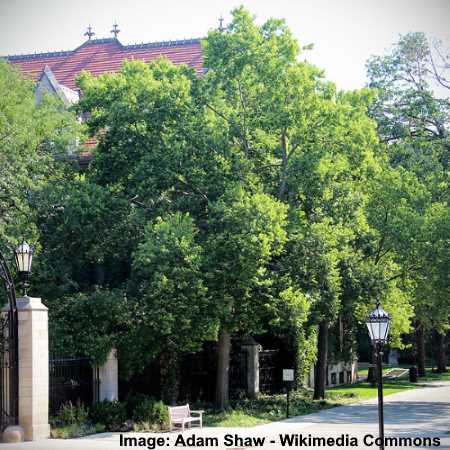
With deciduous glossy to dull green pointed leaves, gray bark, little yellowish flowers, and purple berries, the common hackberry tree (Celtis occidentalis) is a medium to big tree. The crown of mature hackberries is round and spreading, with somewhat drooping branches. Hackberries grow between 40 and 60 feet (12 and 18 meters) tall and broad.
The hackberry tree, which grows well in most situations, is a common hackberry. In full sun or deep shade, the tree thrives equally well. These thrive in rocky, loamy soil as well as clay soil and are often seen growing. Hackberry trees can tolerate drought and flooding, despite their preference for well-drained moist ground. USDA zones 2 to 9 are suitable for hackberry cultivation.
In all seasons, common hackberries make good landscaping trees. The crooked branches are covered in dense foliage and clusters of flowers in the spring. Before the leaves turn yellow in the fall, purple fruits develop in the summer. The light brown corky bark with wart-like protrusions provides winter interest when the leaves fall.
Dense vegetation with ovate leaves 2″ to 5″ (5 – 13 cm) long is characteristic of common hackberry. The serrated margins, uneven base, and visible veins on the leaves distinguish them from others. Leaves on common hackberries turn yellow in the fall, and there’s nothing remarkable about it.
The common hackberry isn’t noted for its beautiful blooms, despite being a flowering tree. Instead, mid- to late-spring (April and May) sees fuzzy clusters of little yellowish-green blooms bloom for a few weeks. Four or five petals, as well as yellowish stamens, make up the flowers.
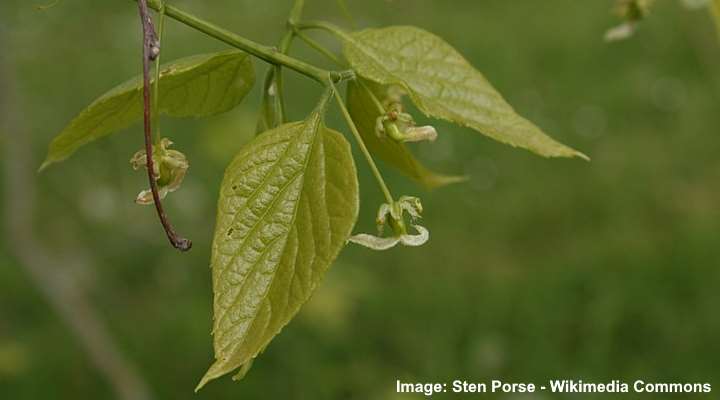
Female blooms produce tiny globular purple berry-like fruits, which are a common hackberry flower. A single seed is found in each round of fleshy fruit. You can eat the sweet drupes raw or make delicious jelly from them, and they are especially popular for birds. Because of their wide, arching crown, common hackberry trees are popular shade trees in residential gardens. This hackberry species may be cultivated as a lawn tree and trimmed regularly to regulate its height.
It’s a messy tree to grow a common hackberry in your yard, which is an issue. Clean-up difficulties can arise from the abundance of autumn leaves and the quantity of seeds. Typically, though, trees near driveways, patios, or sidewalks are the only ones that have this problem.
Hackberry Tree Bark: The hackberry tree trunk has characteristic corkywarts, which are brown or gray ridged or grooved bark.
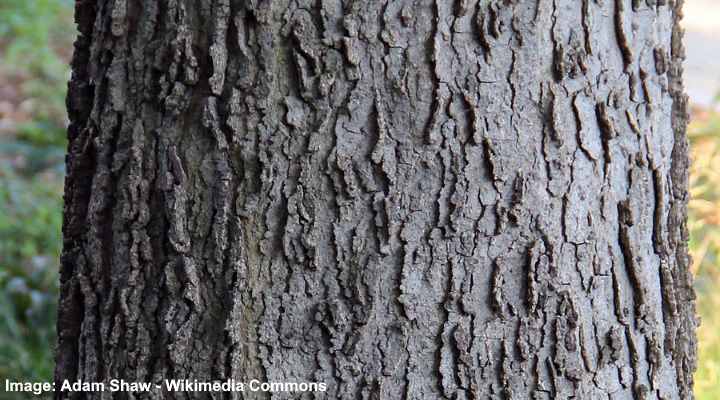
Hackberry Tree Leaves: Serrated edges, asymmetrical rounded base, and oval to lance-shaped leaves The leaves are 3 to 6 inches (7.5 to 15 cm) long. In the summer, deciduous leaves are dull green, while in the fall, they are yellow.

Hackberry Fruit: Sweet-flavoured tiny, spherical, meaty berry-like drupes. A single brown seed is found in each drupe. Birds and people alike enjoy the fruits.

Hackberry Identification: In late summer, look for clusters of yellowish fuzzy-looking flowers and masses of purple berries to identify the common hackberry. With a spreading, rounded canopy, the landscape tree can grow up to 60 feet (18 meters) tall.
Sugarberry (Celtis laevigata)

The sugarberry tree is a native medium-sized tree with pointed leaves, greenish clusters of flowers, and reddish-purple edible fruit. It is also known as the sugar hackberry. Sugarberry trees range in height from 50 to 70 feet (15 to 21 meters) and breadth from 30 to 80 feet (10 to 24 meters).
Southern hackberry is another name for Celtis laevigata. Sugarberries are grown in USDA planting zones of 5 to 10. They can be found from Texas to northern Mexico in the Eastern United States. Look at the leaves to tell the difference between common hackberry and sugarberry. The sugarberry leaves are narrower and have mostly smooth borders when compared to the common hackberry. Sugarberry leaves are approximately 2 to 4 inches (5 to 12 cm) long.
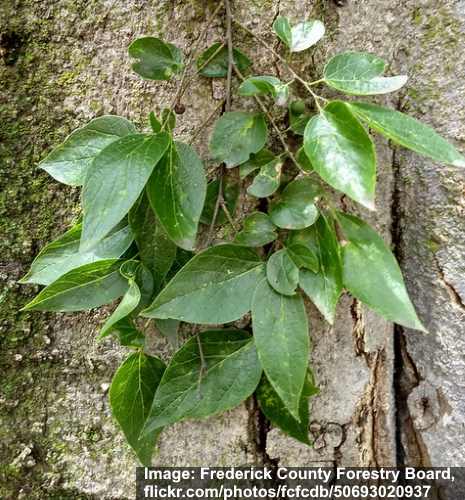
The sugarberry doesn’t tolerate complete shade, as opposed to the common hackberry. Full sun to partial shade is best for the tree. It does, however, toleratehackberrycommonwetandmoistureconditions. Sugar hackberry trees are resistant to witches’ broom, which is one reason to grow them in your garden. The clusters of nest-like branching can appear unsightly, despite the fact that the tree disease has no effect on tree health.
Sugarberry trees have light brown or grey bark, as do other kinds of hackberries. The tree is easily identified in winter because of its smooth bark, which has corky warts on the trunk. Sugar hackberry has a distinct bark that adds seasonal appeal to the tree.
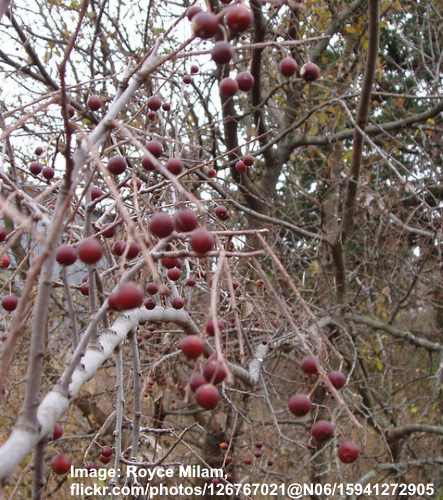
Netleaf Hackberry or Western Hackberry (Celtis reticulata, syn. Celtis laevigata reticulata)
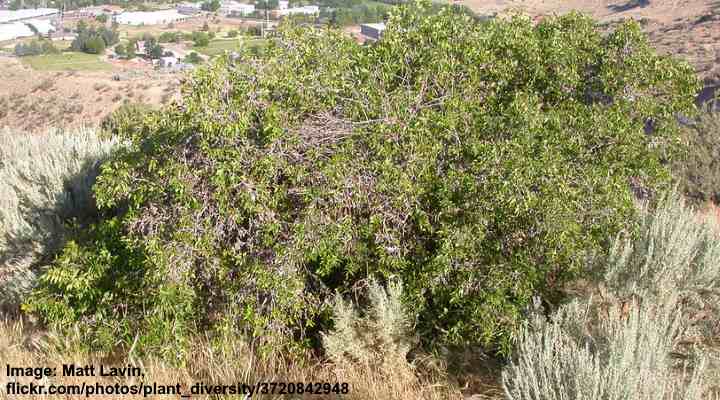
The netleaf hackberry is a tiny deciduous tree with lance-shaped leaves and small clusters of flowers that ripen to reddish-brown to purple berries. It is native to the Western hackberry (Celtis reticulata). The heat-loving and sun-liking tree grows to be around 20–30 feet (6–10 meters) tall. The tree can take on a shrubby appearance in some areas.
The light green, ovate to lanceolate netleaf hackberry leaves, which taper at the tip, are a distinguishing characteristic. Moreover, the blades are glossy and have sunken veins, resulting in the popular term “netleaf.” The oblong-ovate leaves are 1.1 to 3.1 inches (3 to 8 cm) long.

Western hackberry, netleaf sugar hackberry, palo blanco, and Douglas hackberry are some of the other names for Celtis reticulata. From Texas and Louisiana to Arizona, the western hackberry native habitat may be found. Texas, New Mexico, Arizona, and northern Mexico are home to the majority of netleaf hackberries. The netleaf hackberry has corky bark with vertical lines, twisted branches, and tiny spherical fruits, like other types of hackberry.

Western hackberries are distinguished by their broad coverage and uneven, scraggly crown growing in open settings. This hackberry mimics a massive shrub rather than an graceful shade tree.

Male (left) and female (right) flowers of Celtis reticulata
Desert Hackberry (Celtis ehrenbergiana)

The desert hackberry is a huge shrub or small tree with prickly zigzag branches, tiny oblong-ovate rough leaves, small green flower clusters, and orangey or crimson drupes. The hackberry tree has an uneven crown and grows 6 to 12 feet (1.8 to 3.6 meters) tall with its dense foliage.
The Hackberry plant gets its name from its ability to thrive in hot, arid climates. Due to the sharp spines on the branches, the shrub-like tree is also known as spiny hackberry. It is also known as Celtis pallida or Celtis tala by certain botanists. Desert hackberry grows well on sunny, arid sites with rocky soils, making it a kind of desert tree. The thick, leathery leaves of the southern sections stay green all year, but in colder climates, they turn yellow and fall in the fall.
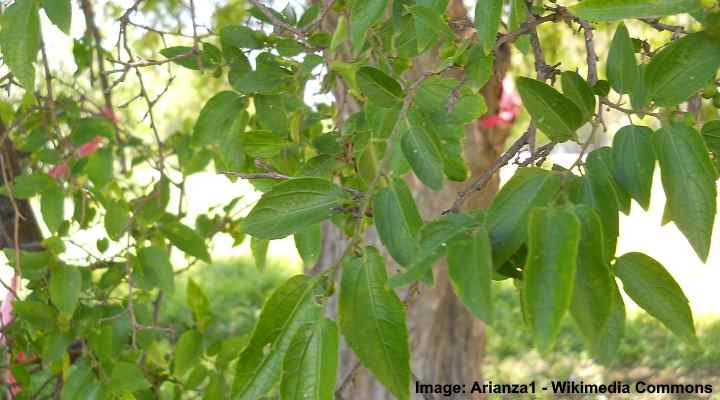
The desert hackberry is one of the few shrubs in the genus, as compared to other types of hackberries.
Dwarf Hackberry (Celtis tenuifolia)

Dwarf hackberry has heart-shaped or ovate leaves, tiny greenish flowers, orange fruits, and dark gray bark. It is a deciduous tree with heart-shaped or ovate leaves. This hackberry species grows between 6 and 30 feet (1.8 and 9 meters) tall and has a 15-foot (4.5-meter) spread as a kind of dwarf tree. From Texas to the eastern coast of the United States, dwarf hackberry trees and big bushes grow wild. The dwarf trees, on the other hand, are more common in the states of Alabama, Georgia, and South Carolina.
The dwarf hackberry, sometimes called Georgia hackberry, has corky, ridged bark, tiny globular berries, and inconspicuous flower clusters in common with other species of hackberries. Before maturity, the drupes change color from orange to red. In the autumn, its leaves become yellowish and are glossy green with pointed ovate edges. For tiny gardens, the dwarf hackberry is an ideal tree or shrub.
The tree’s growth rate is fairly low. It is resistant to shade and thrives in full sun. The dwarf hackberry, on the other hand, is robust in the face of drought and requires minimal upkeep in a garden setting.
